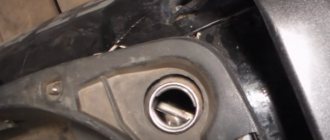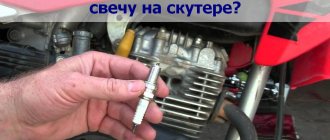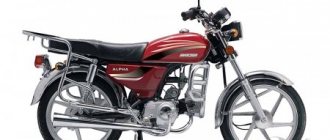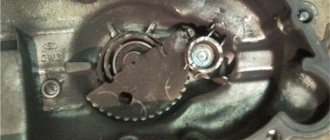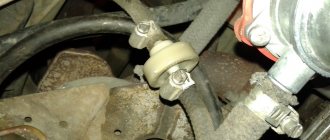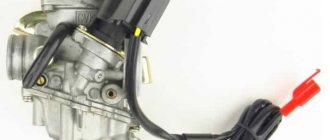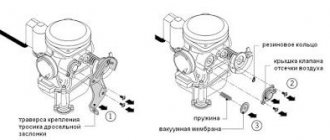Carburetor overflows: possible reasons
Fuel overflow in the carburetor is a common phenomenon, and certainly causes considerable inconvenience to those motorists or motorcyclists who have suffered from it. Most often, such a “sore” is found on Solex and Azon carburetors, installed on many models of cars from AvtoVAZ and on all fuel supply units for mopeds, motorcycles or lawn mowers.
Adjusting carburetor floats
Gasoline often leaks through the sump tube. Why is this happening? Because the floats do not block the flow of fuel from the nozzle. The floats need to be adjusted. To do this, use a suitable screwdriver to adjust the plate connected to the floats, which closes the nozzle. The plate is pressed up or down, depending on the position of the floats. Everything can be checked by simply injecting air into the fuel hose. In this case, the floats must be raised manually. If, with the floats raised, air (simulating gasoline) does not enter the carburetor, then the adjustment operation was successful.
Reasons for the appearance of gasoline in the air filter
In most cases, detection of fuel in the wrong place is a consequence of some other malfunction. In this case, the vehicle may stop starting altogether. The appearance of gasoline in the air filter occurs under the following circumstances:
- during the last trip I fell into a hole;
- the driver forgot to turn off the ignition at night;
- there is a loss of traction, especially at low speeds;
- a decrease in dynamic characteristics, which is especially noticeable when using 50 cc scooters, since they have no power reserve;
- gasoline flows from the carburetor drain hole, both when idle and when driving;
- drops in speed when sharply squeezing the gas handle or accelerator pedal, which is especially noticeable when driving in a traffic jam at a traffic light;
- the gas distribution unit or fuel system, for example, a carburetor, was repaired;
- the engine was running on an over-enriched mixture.
Significant mileage can also cause gasoline to get into the air filter. Physical wear of metal and gaskets leads to the creation of conditions for the occurrence of this malfunction. However, in this case, the engine will gradually start worse and worse, and the strong smell of gasoline from the air filter of a motorcycle or car will not allow the car owner to ignore the breakdown.
Troubleshooting Methods
Most often, if fuel leaks from the filter, owners rush to change the carburetor. The mistakes of this approach to repair are:
- gasoline may enter the air filter not only due to the fault of the carburetor, so replacing it with a new one may not eliminate the problem;
- ridding the float chamber of debris is not a labor-intensive process and is carried out without resorting to financial costs;
- revising the settings of the quality and quantity screws can eliminate the malfunction without dismantling the carburetor.
Therefore, to correct the problem, it is recommended to adhere to the following action plan:
- If there has been interference with the idle speed or mixture settings, check that they are set correctly;
- Check the operation of the vacuum valve. When closed, fuel should not pass through;
- Check the electronic starter enrichment. After turning it off, you need to test run the engine;
- Remove the carburetor and disassemble it;
- If no significant wear, deformation, or damage is visible, blow it out. If plaque or fallen resins are visually detected, the float chamber will need to be flushed;
- Some fuel system designs include a reed valve. It has low maintainability, especially when made of metal. If any bent is found, it is recommended to replace it with a new one.
It is necessary to change the carburetor only if it begins to throw fuel due to excessive wear. In this case, the vehicle has a solid mileage on the odometer and gasoline begins to be thrown into the air filter not unexpectedly, but gradually with increasing volume. Initially, you can only notice the smell, but over time the amount of fuel in the filter can reach 100 - 150 grams.
The most unpleasant situation is when the valve burns out and excessive pressure occurs, pushing fuel into the filter. This situation happens extremely rarely, but you shouldn’t discard it when looking for a breakdown. For diagnosis, it is enough to measure the compression. If its value is low, the engine should be repaired.
Preventing Breakage
The sudden appearance of gasoline in the filter after visiting a gas station indicates dirty fuel. You should stop visiting unverified stations. It is also not recommended to buy fuel while replenishing the storage tank, as the flow from the fuel truck pipe lifts all the debris from the bottom of the tank.
Why do you need to regulate?
During the adjustment process, the scooter carburetor needle is adjusted, the position of which affects the proportions of the air-fuel mixture, as well as a number of other adjustments.
Each tuning operation has a different effect on engine operation and fuel preparation:
- adjusting the idle speed ensures stable operation of a running engine when the transmission is turned off;
- changing the quality of the air-gasoline mixture using a special screw allows you to deplete or enrich it;
- adjusting the position of the carburetor needle affects the change in the quality of the fuel mixture;
- Ensuring a stable level of gasoline inside the float chamber avoids flooding of spark plugs.
A power unit with an adjusted carburetor operates stably in any conditions, is economical, throttle response, develops rated power and maintains speed, and does not cause problems for its owner.
Why does the injector flood the spark plugs?
The reason why the injector spark plugs flood is simple. And it lies in the peculiarities of the “electronic brain” of your car. At subzero temperatures, mixing the fuel-air mixture requires some effort: more oxygen in cold air requires more gasoline.
Interesting materials:
What keeps you warm best? What is better in winter 92 or 95? What can be in the output list in the output statement? What can be included in a court notice? What can affect the lifespan of eyelashes? What might interest a child? What can and cannot be done on Easter? What can you clean with CCleaner? What can you add to roses in a bouquet? What can you add to henna?
Gaskets
Through the cracks in the gaskets, due to the vacuum, fuel can be sucked in, thereby greatly enriching the combustible mixture. It is necessary to carefully visually check the condition of the gaskets and replace if necessary.
The gasket between the bottom of the carburetor and the manifold may also be worn out. On Ozones, experts recommend checking the gaskets between the housing and the throttle valves.
Carburetor petals and fuel return
When the piston moves from bottom dead center, fuel initially rushes back into the carburetor. On high-speed engines, most often used on motorcycles, a reed valve is used to prevent the air-gasoline mixture from escaping. Valves are:
Garage craftsmen advise bending the valve petals if it fails. Practice shows that this is only a temporary measure and repairs with replacement of petals are not far off.
Diagnosis is performed by visual inspection. The presence of burnouts or thermal damage or twists indicates the need to purchase a new reed valve.
Despite the unexpected appearance of fuel in the air filter and the inability to start the engine, during operation you should listen to your bike, scooter, or car. Minor malfunctions in engine operation should alert the owner so that in the future he does not see the air filter pouring gasoline onto the ground.
Fuel overflow in the carburetor is a common phenomenon, and certainly causes considerable inconvenience to those motorists or motorcyclists who have suffered from it. Most often, such a “sore” is found on Solex and Azon carburetors, installed on many models of cars from AvtoVAZ and on all fuel supply units for mopeds, motorcycles or lawn mowers.
Of course, there is nothing good in the fact that the carburetor is flooded, but if the problem has overtaken you, then you need to get rid of it. To do this, it is enough to understand the essence of this malfunction, the reasons for its occurrence and methods of elimination. We will talk about this and much more regarding fuel overflow in the carburetor in the article below.
Posts 1 page 15 of 15
1Wednesday, November 14, 2012 00:20
- Author: serg
- Participant
- From: Odessa
- Registered: Wednesday, November 14, 2012
- Invitations: 0
- Posts: 8
- Respect: [+0/-0]
- Positive: [+0/-0]
- Gender: Male
- Age: 30 [1990-07-04]
- Spent on the forum: 2 hours 31 minutes
- Last visit: Thursday, January 24, 2013 05:20
Hello. Tell me why the carburetor on a Honda Dio 27 moped may overflow. I changed the carbs, the result is the same.
2Wednesday, November 14, 2012 00:54
- Author: Pavel_DV
- Legionary
- From: Khabarovsk Ost. Stepnaya.
- Registered: Thursday, November 10, 2011
- Invitations: 0
- Posts: 503
- Respect: [+1/-0]
- Positive: [+1/-0]
- Gender: Male
- Age: 26 [1994-11-06]
- Time spent on the forum: 8 days 9 hours
- Last visit: Wednesday, August 27, 2014 22:57
Most likely the problem is in crooked hands... how did you determine what is overflowing? by candle
3Wednesday, November 14, 2012 03:06
- Author: serg
- Participant
- From: Odessa
- Registered: Wednesday, November 14, 2012
- Invitations: 0
- Posts: 8
- Respect: [+0/-0]
- Positive: [+0/-0]
- Gender: Male
- Age: 30 [1990-07-04]
- Spent on the forum: 2 hours 31 minutes
- Last visit: Thursday, January 24, 2013 05:20
I determined not by the spark plugs! I START IT, it runs a little and after a minute maybe less, gasoline flows from the carburetor.
4Wednesday, November 14, 2012 07:32
- Author: lavin
- legionary
- Registered: Saturday, August 27, 2011
- Invitations: 0
- Posts: 1621
- Respect: [+5/-0]
- Positive: [+0/-0]
- Gender: Male
- Age: 23 [1997-04-19]
- Time spent on the forum: 23 days 13 hours
- Last visit: Friday, March 5, 2022 18:07
look at the float, set the level in the float chamber. but first, clean it out. Mine was leaking precisely because it was clogged.
5Wednesday, November 14, 2012 13:32
- Author: ChiefiR777
- Honorary Club Member [M]
- From: Khabarovsk
- Registered: Saturday, March 19, 2011
- Invitations: 0
- Posts: 1203
- Respect: [+1/-1]
- Positive: [+0/-0]
- Gender: Male
- Age: 27 [1993-08-07]
- Time spent on the forum: 11 days 8 hours
- Last visit: Saturday, October 27, 2022 06:38
Is your drain valve closed? ,
6Thursday, November 15, 2012 02:22
- Author: serg
- Participant
- From: Odessa
- Registered: Wednesday, November 14, 2012
- Invitations: 0
- Posts: 8
- Respect: [+0/-0]
- Positive: [+0/-0]
- Gender: Male
- Age: 30 [1990-07-04]
- Spent on the forum: 2 hours 31 minutes
- Last visit: Thursday, January 24, 2013 05:20
the drain valve is a bolt on the sump. If it is, then it is tightened. I boiled a new carb, but it still overflows, I tried to set the float, it seemed to be set, but after working a little, it is filled with gasoline, it flows out through the side hole in the carburetor.
7Thursday, November 15, 2012 14:23
- Author: lavin
- legionary
- Registered: Saturday, August 27, 2011
- Invitations: 0
- Posts: 1621
- Respect: [+5/-0]
- Positive: [+0/-0]
- Gender: Male
- Age: 23 [1997-04-19]
- Time spent on the forum: 23 days 13 hours
- Last visit: Friday, March 5, 2022 18:07
the side hole is precisely the overflow. After you set the float, start adjusting with bolts and a needle.
8Friday, November 16, 2012 05:20
- Author: serg
- Participant
- From: Odessa
- Registered: Wednesday, November 14, 2012
- Invitations: 0
- Posts: 8
- Respect: [+0/-0]
- Positive: [+0/-0]
- Gender: Male
- Age: 30 [1990-07-04]
- Spent on the forum: 2 hours 31 minutes
- Last visit: Thursday, January 24, 2013 05:20
I played with the needle, with the fuel supply bolt... but all in vain.....maybe it is overfilling because of the fuel pump itself????
9Friday, November 16, 2012 07:22
- Author: lavin
- legionary
- Registered: Saturday, August 27, 2011
- Invitations: 0
- Posts: 1621
- Respect: [+5/-0]
- Positive: [+0/-0]
- Gender: Male
- Age: 23 [1997-04-19]
- Time spent on the forum: 23 days 13 hours
- Last visit: Friday, March 5, 2022 18:07
in general maybe. try replacing it with a known working one.
10Saturday, November 17, 2012 15:32
- Author: acrobat
- Participant
- Registered: Tuesday, June 26, 2012
- Invitations: 0
- Posts: 14
- Respect: [+0/-0]
- Positive: [+0/-0]
- Time spent on the forum: 11 hours 18 minutes
- Last visit: Thursday, July 11, 2013 10:01
I had a situation on a boat where carbs were leaking. I invited a specialist, and he tormented them for two days. Then he spat, brought new needles, for the third year everything worked like clockwork.
11Saturday, November 17, 2012 22:11
- Author: serg
- Participant
- From: Odessa
- Registered: Wednesday, November 14, 2012
- Invitations: 0
- Posts: 8
- Respect: [+0/-0]
- Positive: [+0/-0]
- Gender: Male
- Age: 30 [1990-07-04]
- Spent on the forum: 2 hours 31 minutes
- Last visit: Thursday, January 24, 2013 05:20
I have a leak from the carb, but it’s not flooding the spark plug. I think that the needle has nothing to do with it….
12Tuesday, December 11, 2012 23:19
- Author: GY6
- Participant
- From: base cafe
- Registered: Friday, December 7, 2012
- Invitations: 0
- Posts: 67
- Respect: [+0/-0]
- Positive: [+0/-0]
- Gender: Male
- Time spent on the forum: 14 hours 33 minutes
- Last visit: Tuesday, April 23, 2013 23:49
13Thursday, December 13, 2012 05:54
- Author: serg
- Participant
- From: Odessa
- Registered: Wednesday, November 14, 2012
- Invitations: 0
- Posts: 8
- Respect: [+0/-0]
- Positive: [+0/-0]
- Gender: Male
- Age: 30 [1990-07-04]
- Spent on the forum: 2 hours 31 minutes
- Last visit: Thursday, January 24, 2013 05:20
this is not a pump...what else could it be???????
14Thursday, December 13, 2012 11:00
- Author: Evgeny Mitin
- Participant
- Registered: Thursday, April 26, 2012
- Invitations: 0
- Posts: 74
- Respect: [+3/-0]
- Positive: [+0/-0]
- Time spent on the forum: 2 days 17 hours
- Last visit: Tuesday, April 28, 2015 00:11
gasoline can flow into the air intake if there is no compression. At the same time, it leaks less if you remove the air cap.
15Thursday, December 13, 2012 13:43
- Author: palladin
- Admin
- From: Khabarovsk
- Registered: Monday, February 20, 2012
- Invitations: 0
- Posts: 1358
- Respect: [+5/-0]
- Positive: [+0/-0]
- Gender: Male
- Time spent on the forum: 25 days 6 hours
- Last visit: Sunday, March 14, 2022 19:04
Post a photo of how your float is set up.
The locking needle is worn out and does not perform its functions
Due to a worn needle, gasoline enters the air filter in the same way as in the case of debris in the carburetor. The symptoms are similar in both cases. Blowing and flushing the carburetor can slightly improve engine performance, but fuel will be thrown into the air filter with the same force.
Diagnostics and inspection of the condition of each element can eliminate the reason why fuel appears in the filter element. In the future, a decision is made to replace components or purchase a new carburetor.
How to remove and clean a scooter carburetor
In order for a scooter engine to operate correctly and steadily and to develop good power, it needs a high-quality working mixture of air, gasoline and oil (if we are talking about a two-stroke engine). This mixture is prepared in a carburetor by mixing the components in certain proportions. And such an important device as a carburetor must be clean in order to work well.
It is recommended to carry out the cleaning procedure for a scooter carburetor at least once every 1-2 thousand kilometers. What are the signs of dirt in the carburetor? First of all, unstable engine operation. That is, vagaries when starting the engine, as well as instability at idle - the scooter can simply stall when stopped.
When I first bought a scooter, cleaning the carburetor seemed no easier to me than assembling and launching a rocket into space. However, having plucked up the courage and got down to business, I was surprised to find that it was very easy to do.
In order to remove and clean the carburetor on a scooter, you will need the following tools and fluids:
- 10mm socket wrench with universal handle and extension
- Phillips and slotted screwdrivers
- tassel
- bath
- gloves
- protective glasses
- aerosol carburetor cleaner
- petrol
Since I prepared in advance to make a report, I will show everything in as much detail as possible.
How to remove a carburetor from a scooter
First you need to remove the seat compartment (toilet) of the scooter by unscrewing the 4 bolts that hold it. On the Honda Tact you will also need to unscrew the oil tank cap.
Now you need to remove the air filter. To do this, you need to unscrew the screw of the clamp securing the cuff to the carburetor, as well as 2 10-point bolts securing the filter housing itself to the engine. You will have to use force to pull the rubber seal of the filter housing off the carburetor.
Next, disconnect the gas hose and oil hose. To do this, you need to squeeze the loops of the clamps and pull off both hoses.
Take the 10mm wrench again and unscrew the near bolt securing the carburetor to the inlet pipe.
Now we go to the interior of the scooter and unscrew the second bolt.
Incorrect operation of the starting enrichment
If gasoline enters the air filter only when the engine is started, you should pay attention to the starter enrichment solenoid valve. Diagnosis is made in two ways:
- 1 Powering the valve directly from the battery;
- 2 Starting the engine when the power supply to the starting enrichment is turned off.
In the first case, diagnostics are performed similarly with a vacuum valve. In the second case, the start will be on a lean mixture, so if fuel is pouring into the filter, then the reason does not lie in the solenoid valve and the search goes further.
Setting in a full opening system
In other words, in the mode of opening the damper at 75 or 100 percent. By changing the main, main jet, this can be achieved. Access to the jet is provided from the outside of the carb, but you need to remove the chamber drain plug.
To determine whether the adjustment was carried out correctly, you need to listen. If you have enough experience, you can determine by ear how the carb is adjusted. If you don’t have enough experience, then you need to look at the candles.
It's done like this.
- A test drive is made with the gas pedal pressed all the way (at the maximum possible speed, but without fanaticism).
- Half an hour after opening the damper, stop the power plant.
- Place the vehicle in neutral, remove and inspect the spark plug.
Based on the appearance of the spark plug, one can conclude about the quality of the fuel assembly. If the insulator is black, then this indicates a rich fuel assembly. On the contrary, if the color of the electrode is light, then the mixture is probably poor. And if the electrode is red, this generally indicates a large number of harmful additives in the fuel. It is better to drain such gasoline and replace it.
Many two-wheeled vehicles use additional jets. They regulate high speeds and act on the solenoid valve. The quality of the fuel assembly can be properly adjusted if you replace these same jets.
Adjusting the needle is also called lapping. This is nothing more than working with a needle valve, which is a moving and essential part of any carb. In some cases, it is useful to simply clean the device, and only after that start adjusting the factory settings (as a rule, they get lost).
For experienced motorcyclists, lapping takes only twenty minutes. But not only problems with the quality of the mixture are eliminated, but also leaks, as well as other difficulties.
It is advisable to grind in with fine-grained sandpaper. You also need to use a special paste. It is applied to the valve in a small amount, then the needle must be moved in different directions.
How to start the engine
If yesterday the scooter was working as usual, but today it doesn’t even start, then most likely the reason for this is hidden in the spark plugs. New owners of such a vehicle do not know how to start the engine. There are two ways to solve this problem. First: take out and dry the candles. But if there is not enough time, then the second option is also suitable: initially you need to leave the scooter for 5 minutes. After this, completely unscrew the throttle and turn the starter. Continue for approximately 15 seconds. At this time, the fuel supply to the chamber will stop and it will be purged with air. This should be enough to start the engine. This method is suitable for those who have a 4T Chinese scooter and who are wondering what to do with a 2T scooter.
If this method does not work, you can try drying the candles. To do this, you need to unscrew these elements, clean the carbon deposits with a brush, and dry them with a hairdryer in the oven or on the stove. When screwing the spark plugs into place, you need to control the gap. After this, the engine should start.
Attention!
If the vehicle is not new, then the spark plugs need to be cleaned more often, or better yet, replaced.
If the spark plugs are constantly filled with gasoline, then diagnostics are required. The spark plugs must be checked for spark quality, the cleanliness of the injectors, and the spark output from the ignition coils must be diagnosed. The Hall sensor is also subject to testing.
The membrane has leaked and is leaking fuel.
The reasons that caused the appearance of holes in the membrane and, as a result, the appearance of fuel in the air filter may be:
- natural wear and tear of the membrane and its physical aging;
- mechanical damage caused by unprofessional repairs;
- Road accident or extreme driving.
A symptom of membrane damage is deterioration of vacuum in the intake manifold and air filter. There is a gradual deterioration in the technical characteristics of the car. It may take more than one month before the iron friend finally stalls.
To determine whether fuel is leaking through the membrane, it is necessary to disassemble the carburetor. Diagnostics is performed by visual inspection.
To repair, you will need to replace the membrane with a new one. Before replacing, you should bleed the carburetor to prevent debris from getting into the jets or under the shut-off needle.
Idle adjustment
There are two ways to adjust the carburetor. It's fast and slow. The slow method is considered the highest quality.
A quick way to adjust idle speed
With the engine running, warmed up and running, use a screwdriver to gradually tighten the quality screw clockwise. We turn the screw until the engine starts to stall.
Next, unscrew the quality screw counterclockwise 2 turns. Use the fuel quantity screw to adjust the engine speed. In summer, on a warm engine, the speed should be 1500 rpm.
If you make the revs lower, then when driving when you let off the gas at speed, the moped will be slowed down by the engine, which is not comfortable.
A high-quality method for adjusting idle speed on a carburetor
With the engine running, use a screwdriver to tighten the speed screw and raise the engine speed to 3500 rpm.
Next, use a screwdriver to adjust the quality screw. We turn it clockwise or counterclockwise until the engine speed reaches its maximum.
We use the quality screw to achieve maximum engine speed and use the speed screw to reduce the speed to 1500 rpm.
Medium and high speed tuning
Using the quality adjustment screw, the fuel proportions at idle speed are ensured. For medium and high rotation speeds, the engine operating mode is adjusted using a different method. After turning the gas handle, the fuel nozzle starts working, supplying gasoline to the diffuser. An incorrectly selected jet cross-section causes a deviation in the fuel composition, and the engine may stall when gaining power.
To ensure uninterrupted operation of the motor at a higher frequency, it is necessary to perform a number of operations:
- remove debris from internal cavities;
- set the gasoline level in the carburetor;
- adjust the operation of the fuel valve;
- check the cross-section of the jet.
The correct operation of the engine is indicated by its quick response when turning the throttle.
A quick response when turning the throttle indicates proper engine operation.
Why does gasoline get into the air filter on a scooter?
A trimmer, both electric and with an internal combustion engine (ICE), is an indispensable tool in the summer and autumn for owners of dachas and private houses. With its help, weeds, small bushes are easily removed and the lawn is trimmed. But, like any equipment, trimmers fail at the most inopportune moment. To troubleshoot problems with your own hands, the user of this equipment first needs to determine the cause of their occurrence.
Main malfunctions of gasoline and electric trimmers In gas trimmers and electric trimmers, if we do not consider breakdowns associated with the bar and mowing head, malfunctions mainly occur in the engine area.
Breakdowns of gasoline trimmersTypical breakdowns of a gasoline trimmer that owners of this unit most often encounter are the following:
engine breakdown;carburetor problems;fuel supply problems;muffler malfunction;gearbox failure;starter broken;air filter problems;breather on the gas tank clogged. Gasoline trimmer
Fuel tank (fuel quality) Remember that the presence and quality of fuel must always be checked before starting the unit. In this case, you shouldn’t be greedy and save money, or “get smart” about the amount of oil added. Everything must be done in accordance with the manual supplied with the device, since if the piston group fails, replacing it will cost about 70% of the total cost of the trimmer. Fill with fuel in the expectation that you will completely use it up when performing the work. Gasoline remaining in the tank loses its properties after some time and can harm the engine. Therefore, do not prepare the mixture for future use or in large quantities. If the lawn mower has trouble starting, try draining the “old” fuel from the tank and refilling it with a freshly prepared mixture.
Trouble-shooting
What to do if you had to face such problems? Let's go in order. You need to start with the air filter - if there are no problems with it, then proceed to the next steps.
Fuel tap problem?
If gasoline constantly flows from the fuel supply hose, even when the vacuum hose is removed, then the valve is faulty. It simply does not work, but is always in the open position. In this case, the tap must be replaced with a new one.
If, when you remove the vacuum hose, gasoline stops flowing, then the reason is a constant vacuum - you need to climb into the cylinder head.
Locking needle
Provided the faucet is in good working order, you can play the shut-off game. How to get to the needle of a scooter or moped?
- To remove the carburetor, you need to disconnect the air filter; hoses suitable for it; unscrew it from the intake manifold and remove the throttle cable.
- Next, use a Phillips screwdriver to remove the float chamber housing.
- Assess the condition of the shut-off needle and float antennae.
- If necessary, replace the needle and bend the float antennae. If the needle is in good condition, then its seat should be thoroughly washed and blown out.
- Reassemble everything and install it on the engine.
Vacuum accelerator (if all else fails)
In addition to the locking needle, Chinese scooters are also equipped with a vacuum needle (vacuum accelerator). This device also works from a vacuum hose connected to the “carb”. This needle has 5 (usually) adjustment positions. When the scooter accelerates, the vacuum opens this needle and more fuel is supplied to the combustion chamber.
The system is correct, however, everything breaks down. Over time, none of the needle positions produces results. This problem can be solved simply by removing or cutting the vacuum hose (not the one to the fuel tap)! And the engine no longer overflows - miracle of miracles.

